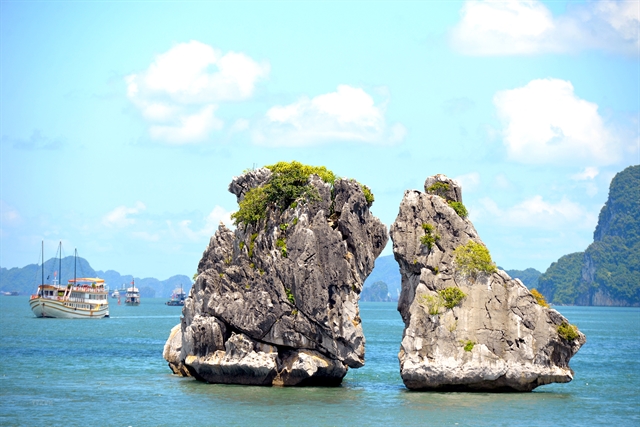 Life & Style
Life & Style

 |
| Hòn Trống Mái (Kissing Rocks), a symbol of Hạ Long Bay in the northern Quảng Ninh Province needs protection avoid collapsing. VNA/VNS Photo Thanh Vân |
QUẢNG NINH The iconic Hòn Trống Mái (Kissing Rocks), emblematic of Hạ Long Bay in Quảng Ninh's northern province, faces threats due to geological processes and rising sea water levels, as highlighted by a study from the Institute of Geosciences and Mineral Resources.
Covering an approximate area of 1,553 sq.km, Hạ Long Bay boasts significant geological and geomorphological value, making it a distinct tourist attraction not just for Quảng Ninh but also for the northern region.
Hạ Long Bay is dotted with thousands of islets, each unique in shape and size. Amongst these, the standout islets are the two chicken-shaped rocks – a rooster and a hen, known as Hòn Trống Mái, that face each other.
Standing roughly 13.9m tall, the base of Hòn Trống Mái is more slender than its upper structure. Due to geological and tectonic movements, along with the influence of sea water levels, the rocks present a single tilted structure with multiple fractures.
“There are many factors affecting Hòn Trống Mái such as waves, wind, water, tides, currents, plants and people,” said Hồ Tiến Chung, head of Tectonic and Geomorphology Department of the institute.
“Tourists can see the rocks that are precarious at the time of low tide. The water level is low, exposing the supporting foot of the rocks which are gradually being eroded causing the risk of collapse if no measures are taken to protect and reinforce them soon.”
The vicinity of Hòn Trống Mái encompasses a floating area of roughly 400 sq.m, primarily made up of Carboniferous - Permian limestone. The institute disclosed last month that nearly 40 rocks in this region are at peril of sliding and toppling.
Human activities, including illegal fishing and unregulated tourism, further hasten the erosion and landslide processes in the Hòn Trống Mái zone, as noted by Chung.
Although tourists aren't permitted to approach the rocks, the passage of tourism vehicles continues to detrimentally affect them.
In 2016, the 'head' of the renowned Thiên Nga (Swan) islet in Hạ Long Bay detached and plummeted into the sea.
To counteract the corrosion at the base of the rocks, the institute's experts suggest implementing technical solutions.
Moreover, they recommend that the Hạ Long Bay management board introduce measures to regulate the movement of tourism vehicles. This would involve controlling the speed of boats in the vicinity of the rocks and educating local fishermen to refrain from operating around Hòn Trống Mái. VNS